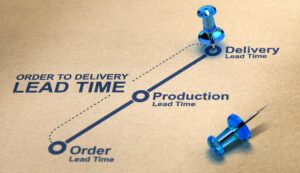
Manufacturers often measure success by how efficiently they use equipment or how much they cut costs. Those numbers are easy to capture on a dashboard. Yet efficiency and cost alone rarely explain why some companies consistently win business while others struggle to keep up.
A growing body of evidence points to another factor that matters even more: lead time.
Why Lead Time Changes the Game
Customers rarely care whether a machine is running at 85 percent utilization or whether labor efficiency improved by two points. What they do care about is whether their order shows up on time, whether changes can be accommodated, and whether the supplier can respond quickly to evolving needs.
In a newly published article in the Journal of Operations Management, UW–Madison Emeritus Professor Rajan Suri, founder of the Center for Quick Response Manufacturing (QRM), explains why lead time is the overlooked driver of competitiveness. His research shows that focusing on shortening lead times can simultaneously improve quality, lower costs, and make companies more adaptable to customer demand.
When Speed Outperforms Efficiency
Traditional metrics like utilization and efficiency can sometimes work against responsiveness. A plant that insists on running equipment at maximum utilization may generate long queues of work-in-process. That slows the overall system and lengthens lead times.
By contrast, companies that design operations around shorter lead times often discover that costs go down as well. Less work-in-process means lower inventory carrying costs. Fewer queues mean less expediting and rework. Quality improves when jobs move quickly through the system instead of waiting in piles on the shop floor.
Speed is not just a customer benefit. It can also be a financial benefit.
A Case in Point: RenewAire
One Wisconsin manufacturer put these ideas into practice with striking results. RenewAire, a producer of customized energy recovery ventilation systems, once struggled with long lead times and constant firefighting to meet customer needs. By applying QRM principles and focusing on lead time reduction, RenewAire achieved a 140 percent growth in revenue in just five years while also improving on-time delivery and customer satisfaction.
Their story illustrates a broader truth: manufacturers that reduce lead time do more than move work more quickly: They become more competitive.
Measuring What Matters
To help companies make lead time a management priority, QRM developed a clear, consistent metric called Manufacturing Critical-path Time (MCT). MCT measures the total calendar time from when a customer order is received until the first unit is delivered. Unlike traditional delivery lead time, which can be masked by stock already on the shelf, MCT shows how long it really takes to fulfill an order when starting from scratch.
Companies that use MCT gain a reliable way to benchmark performance, compare results, and focus improvement efforts where they matter most.
Moving Forward
Today’s manufacturers face a paradox: pursuing efficiency can actually create delay. Highly utilized equipment and large batch sizes may look productive, but they slow the flow of work and extend lead times, exactly what customers don’t want. In an era of high-mix, low-volume production, the companies that thrive are those that can respond to this variability quickly. That is why lead time, not just efficiency and cost, is the metric that sets winners apart.
If you want to dig deeper into this research, you can read Professor Suri’s full article in the Journal of Operations Management here.
And if you’re interested in applying these principles directly to your work, explore the QRM courses offered through UW–Madison. These hands-on programs are designed for practicing engineers and managers who want to shorten lead times, boost responsiveness, and sharpen their competitive edge.